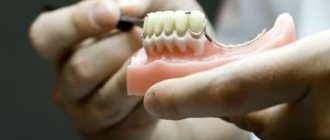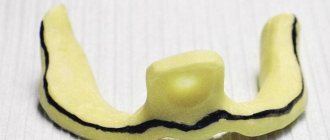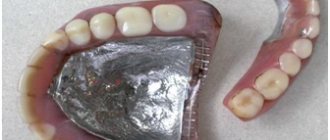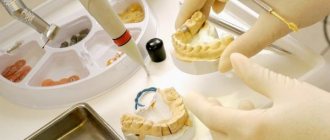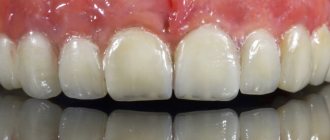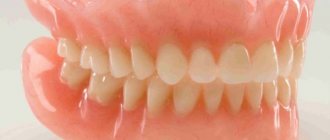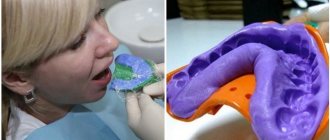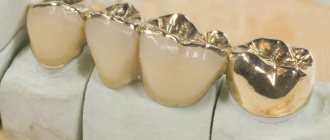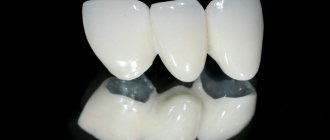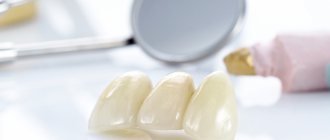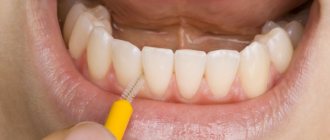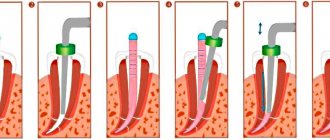Today we will talk about orthodontic structures such as temporary crowns .
We will discuss their features, types, indications for use, functional characteristics, materials from which they are made and installation steps.
We will also pay attention to the service life of these prostheses, why they are needed and much more on this topic.
Temporary crowns are a separate type of dental elements that are installed in place of a permanent crown while it is being manufactured.
The main functions of such prostheses:
- protection of the pulp from the negative influence of pathogenic microorganisms;
- preventing displacement of treated and adjacent teeth;
- formation of the gingival margin and prevention of gum growth when treating teeth with a special ledge;
- reconstruction of occlusion during therapy for increased wear of chewing elements;
- continuation of the full functionality of teeth;
- acceleration of adaptation to the modernized chewing element, which will take the place of the affected one after installation;
- maintaining the aesthetic appearance of the oral cavity.
Many people are concerned about the question: how long can temporary crowns be worn? The answer is simple - the entire period allocated for the manufacture of permanent dentures.
This may even take a couple of months. When these orthodontic structures are worn for a long time, they wear out, which will lead to the displacement of adjacent teeth.
Inflammation of the gingival margin also occurs due to bacterial contamination of the plastic. Sometimes the crown breaks, followed by gum growth and pain.
The production of such crowns is much faster than their permanent counterparts.
Regardless of what material modern crowns are made from, they are fixed with temporary cement. Such material gradually dissolves under the influence of saliva.
Sometimes it becomes necessary to attach temporary dentures after implantation. This is because it is important for the gums to return to the desired shape after this type of intervention, and non-permanent crowns can help with this.
Before installing a permanent prosthesis, the implant must take root. The average period of its integration in the upper jaw is about six months, and in the lower jaw – 4 months.
The lower jaw is better supplied with blood, and it is larger and stronger, since it bears more chewing load.
While it takes root, the patient wears a temporary crown, which imitates a regular tooth, protecting the gums from inflammation.
Dentures are placed on an implant when the dental nerve is removed and it is not possible to restore the chewing element.
Why do they put it?
The first reason for installing such a structure is that it will remain on the tooth while the permanent is missing and is made in a technical laboratory. Firstly, it will protect against damage, and secondly, it will resist the formation of plaque on the stump. Thirdly, a plastic crown holds the gum, which can float onto the ledge of the treated tooth.
Temporary structures are also used in cases where, for various reasons, the installation of a permanent crown is postponed for some time. For example, when a tooth is already prepared for prosthetics, and the one next to it is just being prepared.
Another indication is the work of an orthopedic doctor with gums. Any crown must “cling” to the tooth tissue. But sometimes they are located below the gum level. Processing in this way can damage the soft tissue around. When damaged, they bleed, creating pores in the impression. These flaws are transferred to the plaster model, which gives rise to inaccuracies and, as a result, a loose fit. All these factors worsen the quality of work, and with it the service life of the structure. The impression must be taken from a dry surface. In such cases, a temporary plastic crown with a polished edge is made. It is fixed with cement and the patient is released for a period of 3 to 10 days. During this period, the gums are restored, and the working impression is of better quality.
When it comes to the frontal group of teeth, we can talk about provisional crowns - temporary restorations that allow you to find out what the permanent structure will look like in the oral cavity. This type is used if it is necessary to level the gingival zeniths (peak points of the edge) in an aesthetically significant area. This is done so that all the outlines of the gums look symmetrical and organic. Speaking about provisional restorations, one cannot fail to mention the “Mock up” technology (translated from English as “mock-up”). This is a way to transfer a modeled design from a technical model directly to your teeth. In fact, this can be called a test drive of the design. It is divided into two types: assessment directly in the doctor's chair and long-term wear. We'll talk about the difference between them a little later.
Provisional structures can also include a plastic crown on an implant. The first advantage is that the patient receives the long-awaited tooth in the near future. The second is working with the gums. When an orthopedic surgeon uses provisional crowns in the implant area, he can adjust the neck of the structure, which allows him to create an eruption profile identical to a living tooth.
If a patient requires treatment with a braces system, and he has “dead” teeth or those covered with permanent crowns, then this fact creates some difficulties. The fact is that anything sticks very poorly to ceramics. And braces are no exception. In such cases, the doctor resorts to structures made of plastic material for long-term wear. They either cover teeth that need it, or replace crowns with ceramics of the above-mentioned type. After orthodontic treatment, ceramic ones are installed instead of plastic ones.
The only contraindications include allergic reactions. But when using this type of structure this happens extremely rarely. If we talk about disadvantages, then, firstly, it is insufficient strength, which makes it unprofitable to use them as permanent ones. Secondly, the porosity of the material for temporary crowns makes oral hygiene difficult. And of course, in this regard, such structures are an excellent place for the growth and reproduction of microorganisms. But, if the terms of wearing are observed, this minus does not develop into a problem.
Methods for installing temporary crowns
There are 2 most common methods of installing temporary crowns: direct and indirect.
In the first option, dentures are made directly in the patient’s mouth. Before preparing the tooth, an impression is taken from it with silicone mass.
The dentist then prepares the tooth stump, after which he inserts temporary material into the impression and places it in the oral cavity.
The temporary crown is thus obtained according to the shape of the tooth before treatment. After the material has hardened, the temporary prosthesis is processed according to the bite, polished and fixed with cement.
When using the indirect method, the dentist takes an impression of the teeth and sends it to a dental laboratory. The dental technician makes a plaster model, on which he restores the shape of the chewing element from wax, and sends this specimen back to the clinic.
During the second visit, the orthopedic dentist takes a silicone impression from the plaster model and, after preparing the tooth, makes a prosthesis.
Temporary crowns produced indirectly have some advantages: they are more reliable and durable.
From an aesthetic point of view, the greatest demands are placed on dentures that are temporarily installed on the front teeth.
Materials for temporary crowns
The most common material used in the production of temporary crowns is plastic.
It's all about its cheapness and good color capabilities.
The plastic can be given any shade to integrate the prosthesis into the dentition without compromising the aesthetics of the smile.
However, if you wear such a crown longer than the intended time, it begins to darken. Its advantages also include ease of manufacture and installation.
Some clinics use composite materials for prostheses based on acrylic and its derivatives; they have good reviews among users.
Whatever element the dentist installs for you, it may differ in individual characteristics, since different materials have different indicators of manufacturing time, toxicity level, hardening rate, service life, ease of modeling, degree of strength and the ability to correct the shape of the structure if necessary.
Plastic temporary crowns also have their disadvantages: a pronounced porosity of the structure, due to which pathogenic microflora has every chance of penetrating deep into the material. Over time, bacteria will reach the tooth stump and cause inflammation.
As we mentioned above, this material can change its original color. Red wine, coffee, black tea and other products that have the property of staining enamel can affect the modification of dentures, and in a fairly short time.
Temporary plastic structures do not last long. The service life ranges from several weeks to two years and depends on the manufacturing conditions: in the dentist’s office or in a dental laboratory.
Based on synthetic polymers, plastic is widely used in almost all areas of medicine, not only in orthodontics. This material is able to form under the influence of heat and pressure and maintain a given shape after cooling or hardening.
This property makes it easy to work with plastic and give it the desired configuration without much effort. Plastic is divided into: thermoplastics, thermosets and gas-filled polymers.
The first option is used in dentistry. This material is characterized by low density, extremely low electrical and thermal conductivity, and not very high mechanical strength.
The cost of plastic is quite low, which directly affects the price of goods that are made from them.
Disadvantages of plastic crowns –
The reason for the short service life of plastic crowns is their significantly lower strength (compared to any other types of crowns), as well as the high rate of abrasion of the chewing surface. As a result, with prolonged use there is a high risk of fractures and cracks in the frame of plastic crowns.
The patient can warn the doctor in advance that for some reason he plans to wear temporary crowns for longer than expected (for example, several months or more).
In this case, your doctor will probably suggest that you make temporary crowns with a reinforced fiberglass or metal mesh frame.
But you need to be prepared that the cost of each such crown will be 2000-3000 rubles more - compared to a regular plastic crown.
How long can you walk with temporary crowns? In general, walking for more than 1 month with temporary plastic crowns is not recommended.
Firstly, they have a rather negative effect on the gums around the crown, promoting the development of inflammation in it.
Secondly, they have a fairly low manufacturing accuracy and may not fit tightly around the neck of the tooth, which can lead to saliva and bacteria getting under the crown and rotting of the tooth tissue.
The mechanical strength of a temporary plastic crown will depend on its thickness.
For example, for metal-ceramics, the tooth is ground on all sides by an average of 1.5 - 2.0 mm, and in this case the plastic crown on the tooth is thick and strong enough to last for quite a long time (however, if you plan to wear such crowns for six months and more - in any case, their frame needs to be additionally reinforced).
Disadvantages of plastic crowns –
- low strength,
- rapid abrasion of the chewing surface as a result of friction against antagonist teeth,
- plastic is capable of absorbing odors, and therefore after a while begins to emit an unpleasant odor and taste,
- plastic is capable of absorbing dyes, and with prolonged use it acquires a dirty gray color,
- plastic has pores that are gradually colonized by bacteria and subsequently serve as a source of infection,
- chemical components of plastic can cause allergic reactions,
- with prolonged contact with the gums, plastic crowns contribute to the development of inflammation in it,
- temporary crowns, as a rule, have a fairly low accuracy of fit to the neck of the tooth, which, with prolonged use of crowns, can lead to the onset of rotting of the tooth tissue,
- plastic crowns are not suitable for permanent prosthetics also because the supporting teeth under them would be subjected to very strong grinding (in order to make the walls of the crown thicker and stronger).
Important: in some cases, the safety margin of plastic crowns may last quite a long time - from 1 to 2 years (for example, if the frame was additionally reinforced), but in any case, we do not recommend using plastic crowns for more than 2-3 months, because this can cause significant harm to the condition of both the supporting teeth themselves and the gums around the crowns.
Temporary dentures for the front teeth
If the absence of lateral teeth can still go unnoticed, then the absence of at least one front tooth, especially in the upper jaw, immediately catches the eye when communicating.
Making permanent crowns takes about 10 days, so during this period the ground teeth are replaced with temporary crowns made of plastic or acrylic.
These materials are not suitable for long-term wear, as their quality is much lower than that of their permanent counterparts.
However, they do their job perfectly well for a period of 2-4 weeks. Provisional crowns, as they are also called, are needed not only to hide the defect (and the ground tooth does not look the best), but also to protect against the influence of the external environment (temperature, food plaque, acids).
Do not wear temporary crowns longer than the period specified by your doctor, as they will quickly lose their original properties.
Plastic is stained by drinks and food with coloring pigments, and pathogenic microorganisms can penetrate its porous structure and cause inflammation.
Types of temporary structures
Temporary crowns are divided into standard ones, produced in whole sets, and individually made ones. Custom crowns are usually made in dental laboratories after impressions are taken from the patient. Such structures have the correct shape and high aesthetics. However, if it is necessary to cover the tooth with a crown as soon as possible, the dentist can make a temporary prosthesis himself during the appointment. Of course, such crowns are not of high quality and impeccable appearance, but they cope with their functions perfectly.
Unfortunately, there are complex clinical cases when temporary crowns have to be used more than once or twice. And it is not possible to use the same design over and over again. However, spending money on the production of temporary prostheses is completely justified, because as a result, the quality of orthopedic treatment increases significantly.
Today, orthopedic dentists try to prevent the patient from walking around with ground teeth while waiting for a permanent prosthesis to be installed. The use of temporary crowns not only improves the quality of life during orthopedic treatment, but also allows you to achieve better and more durable results with prosthetics.
Source: gelio-a.ru
Removing temporary crowns
Temporary crowns can be removed quite easily. Over time, the cement on which they were installed becomes loose.
So, it will not be difficult for the dentist to quickly and painlessly remove it.
You can ask your treating dentist how temporary crowns are removed; he will explain this simple procedure to you in detail.
If the crown slips, you must visit the dentist to re-fix it with temporary cement. In the meantime, it is not possible to get to the dentist, it is better to return the structure to its original place.
At night and during meals, it is better to remove such an orthodontic element from the mouth. You can store it in a glass of water.
The COST of these prostheses ranges from $10-30. Their prices are low, so anyone can buy or order their installation.
How to remove crowns - modern techniques and indications for removing a crown from a tooth
One of the most popular forms of dental prosthetics is bridges and crowns. A bridge is a structure that must contain at least three crowns. Dentists assure that they can last about fifteen years. In exceptional cases, their service life may be slightly shorter. Important note: all dentures should only be removed by a dentist.
When to remove dental structures
Indications for crown removal may include:
- Unpleasant odor coming from under the crown.
- Pain while chewing or at rest.
- Replacement with a higher quality or visually similar to natural design.
If pain occurs, you should immediately consult a doctor for advice. Pain can occur if the denture was incorrectly manufactured or installed and thus rubs the soft tissues in the oral cavity.
In this case, there may be a possibility of an inflammatory process. After consultation with the dentist, he may decide to remove the crown and replace it with a newer and better one.
Incorrect fixation of the structure
The most common phenomenon is considered to be de-cementing of the structure. The patient will notice this immediately - it will be difficult for him to talk and eat, and the crown will constantly wobble. The problem appears due to the fact that the dentist made a mistake when cementing or used low-quality bonding materials during the work.
Pain under the crown may indicate that the dentist did not properly treat the teeth before placing the crown. Pain may indicate the development of pulpitis, caries, periodontitis and other dental diseases.
Is it possible to remove the crown yourself?
Unfortunately, toothache is such that sometimes it is impossible to endure. In this case, a person may want to remove the crown himself, without having any knowledge of how to remove the crown at home correctly. Unfortunately, such independent attempts can only bring serious complications.
If the prosthesis comes off at the same time as the cement base, it can be removed at home.
What removal methods are there?
Today in dentistry there are many materials that are used for the production of dentures. Depending on what designs were used, there are differences in removing different crowns from teeth.
The most common crown removal methods:
Using the Koch apparatus. This is a special machine that needs to be put on the prosthesis. Work process: using jerking movements, the material that holds the entire crown structure is broken. Next, using dental forceps, the crown is removed from the tooth.
Using the Coronaflex device. Helps remove the prosthesis, as well as preserve it for future installation. Does not harm the tooth. Compressed air is used for operation. The disadvantages of the device include the high cost of the procedure.
Using ultrasound (when decementing is carried out). Unfortunately, not all bonding materials can be broken down using ultrasound. Glass ionomer cement will only get harder.
By sawing. Because of its roughness, it is used to remove durable dentures (for example, ceramic ones). The most cost-effective procedure. Does not harm the tooth stump, does not cause pain to the patient. The disadvantages include duration and anesthesia.
How to properly remove a crown
A more detailed removal process can be seen in the photo of how crowns are removed. First, the dentist must examine and assess the condition of the patient’s oral cavity. If the situation is severe, anesthesia may be used.
After the doctor prepares the mouth, he can begin detachment. Without an examination, it is impossible to say how permanent crowns are removed - the doctor will tell you this on an individual basis.
After the bridge or crown has been removed, the doctor must evaluate the structure for integrity. Next, a decision is made - whether to reuse it or whether it is necessary to make a new one.
If you need a new crown, you need to carefully choose the material.
As you can see, there is nothing wrong with how crowns are removed from teeth. The most important thing is not to neglect your teeth and, as soon as necessary, consult a doctor for a consultation.
Photo instructions on how to remove crowns
Help the project, share your review
